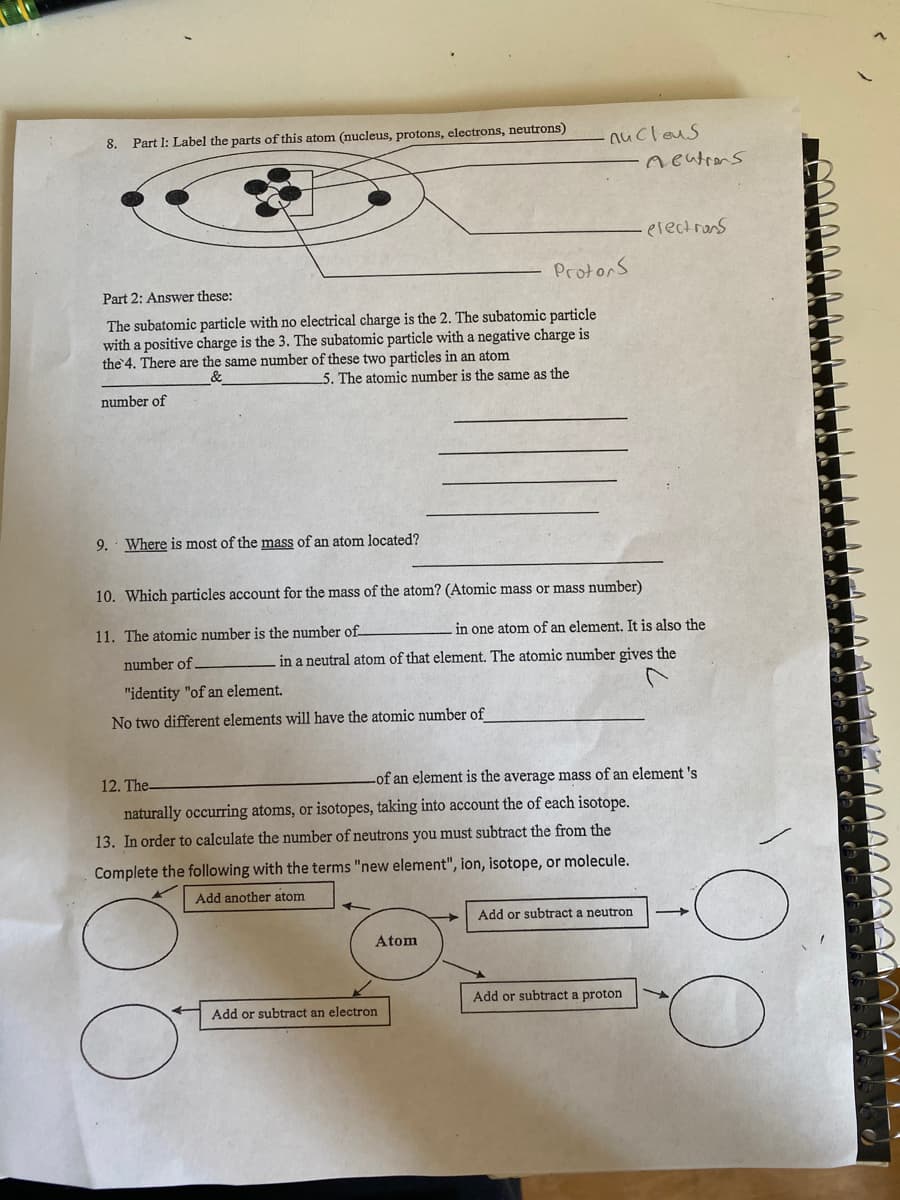8. Part 1: Label the parts of this atom (nucleus, protons, electrons, neutrons) nucleus neutrens electrons Protors Part 2: Answer these: The subatomic particle with no electrical charge is the 2. The subatomic particle with a positive charge is the 3. The subatomic particle with a negative charge is the 4. There are the same number of these two particles in an atom 5. The atomic number is the same as the number of 9. Where is most of the mass of an atom located? 10. Which particles account for the mass of the atom? (Atomic mass or mass number) 11. The atomic number is the number of in one atom of an element. It is also the number of. in a neutral atom of that element. The atomic number gives the "identity "of an element. No two different elements will have the atomic number of 12. The -of an element is the average mass of an element 's naturally occurring atoms, or isotopes, taking into account the of each isotope. 13. In order to calculate the number of neutrons you must subtract the from the Complete the following with the terms "new element", ion, isotope, or molecule. Add another atom Add or subtract a neutron Atom Add or subtract a proton Add or subtract an electron 00
8. Part 1: Label the parts of this atom (nucleus, protons, electrons, neutrons) nucleus neutrens electrons Protors Part 2: Answer these: The subatomic particle with no electrical charge is the 2. The subatomic particle with a positive charge is the 3. The subatomic particle with a negative charge is the 4. There are the same number of these two particles in an atom 5. The atomic number is the same as the number of 9. Where is most of the mass of an atom located? 10. Which particles account for the mass of the atom? (Atomic mass or mass number) 11. The atomic number is the number of in one atom of an element. It is also the number of. in a neutral atom of that element. The atomic number gives the "identity "of an element. No two different elements will have the atomic number of 12. The -of an element is the average mass of an element 's naturally occurring atoms, or isotopes, taking into account the of each isotope. 13. In order to calculate the number of neutrons you must subtract the from the Complete the following with the terms "new element", ion, isotope, or molecule. Add another atom Add or subtract a neutron Atom Add or subtract a proton Add or subtract an electron 00
Horizons: Exploring the Universe (MindTap Course List)
14th Edition
ISBN:9781305960961
Author:Michael A. Seeds, Dana Backman
Publisher:Michael A. Seeds, Dana Backman
Chapter9: The Formation And Structure Of Stars
Section: Chapter Questions
Problem 1DQ
Related questions
Question
100%
I need help with this worksheet

Transcribed Image Text:8.
Part 1: Label the parts of this atom (nucleus, protons, electrons, neutrons)
nucleus
neatrens
electrons
Protors
Part 2: Answer these:
The subatomic particle with no electrical charge is the 2. The subatomic particle
with a positive charge is the 3. The subatomic particle with a negative charge is
the 4. There are the same number of these two particles in an atom
5. The atomic number is the same as the
number of
9. Where is most of the mass of an atom located?
10. Which particles account for the mass of the atom? (Atomic mass or mass number)
11. The atomic number is the number of
in one atom of an element, It is also the
number of.
in a neutral atom of that element. The atomic number gives the
"identity "of an element.
No two different elements will have the atomic number of
12. The
of an element is the average mass of an element 's
naturally occurring atoms, or isotopes, taking into account the of each isotope.
13. In order to calculate the number of neutrons you must subtract the from the
Complete the following with the terms "new element", ion, isotope, or molecule.
Add another atom
Add or subtract a neutron
Atom
Add or subtract a proton
Add or subtract an electron
100
Expert Solution
This question has been solved!
Explore an expertly crafted, step-by-step solution for a thorough understanding of key concepts.
This is a popular solution!
Trending now
This is a popular solution!
Step by step
Solved in 2 steps with 2 images

Knowledge Booster
Learn more about
Need a deep-dive on the concept behind this application? Look no further. Learn more about this topic, physics and related others by exploring similar questions and additional content below.Recommended textbooks for you

Horizons: Exploring the Universe (MindTap Course …
Physics
ISBN:
9781305960961
Author:
Michael A. Seeds, Dana Backman
Publisher:
Cengage Learning

Stars and Galaxies (MindTap Course List)
Physics
ISBN:
9781337399944
Author:
Michael A. Seeds
Publisher:
Cengage Learning

Astronomy
Physics
ISBN:
9781938168284
Author:
Andrew Fraknoi; David Morrison; Sidney C. Wolff
Publisher:
OpenStax

Horizons: Exploring the Universe (MindTap Course …
Physics
ISBN:
9781305960961
Author:
Michael A. Seeds, Dana Backman
Publisher:
Cengage Learning

Stars and Galaxies (MindTap Course List)
Physics
ISBN:
9781337399944
Author:
Michael A. Seeds
Publisher:
Cengage Learning

Astronomy
Physics
ISBN:
9781938168284
Author:
Andrew Fraknoi; David Morrison; Sidney C. Wolff
Publisher:
OpenStax

College Physics
Physics
ISBN:
9781938168000
Author:
Paul Peter Urone, Roger Hinrichs
Publisher:
OpenStax College

An Introduction to Physical Science
Physics
ISBN:
9781305079137
Author:
James Shipman, Jerry D. Wilson, Charles A. Higgins, Omar Torres
Publisher:
Cengage Learning